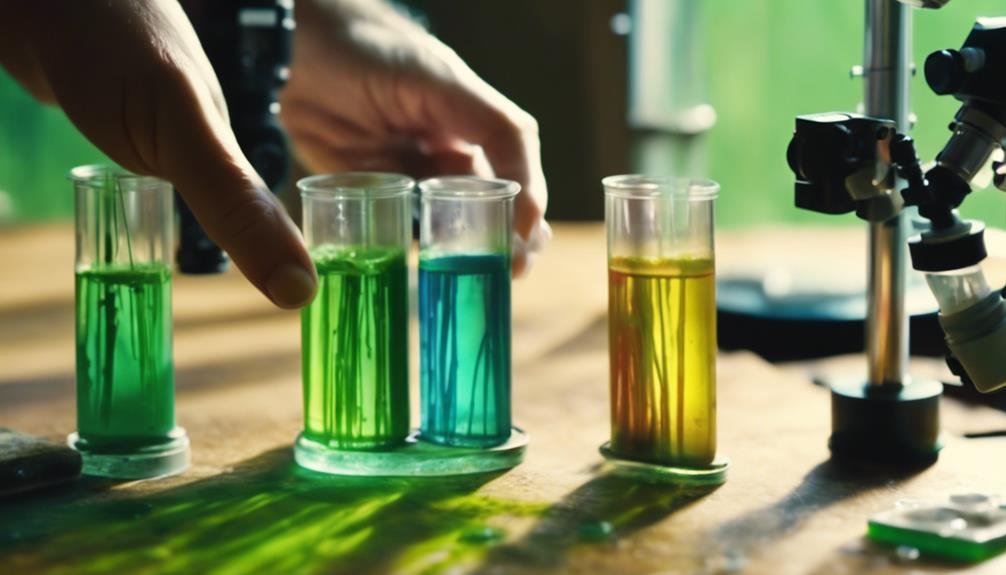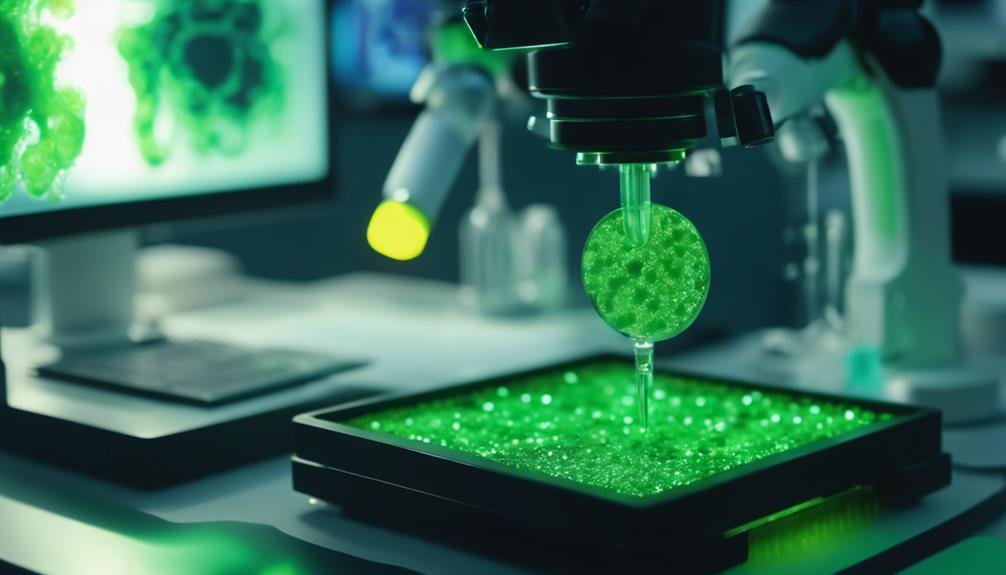Water testing is vital for effective algae management. It helps you detect nutrient imbalances, pH fluctuations, and water clarity issues that can lead to algal blooms. Regular monitoring allows you to identify common algae types like cyanobacteria, green algae, and diatoms. You'll be able to implement targeted strategies based on test results, such as aeration systems or nutrient remediation. Water testing also aids in early detection of harmful algae species and assesses the effectiveness of control measures. By understanding your pond's unique chemistry through testing, you'll prevent water contamination, protect aquatic ecosystems, and guarantee compliance with environmental regulations. Discover how water testing can revolutionize your algae management approach.
Importance of Water Testing
Water testing isn't just a necessity; it's an essential step in managing algae and maintaining healthy aquatic ecosystems. When you engage in regular water quality monitoring, you're taking proactive measures to guarantee the overall health of your ponds and lakes.
This process allows you to detect potential issues early on, such as nutrient imbalances and pH fluctuations, which can contribute to excessive algae growth.
By implementing a consistent water testing routine, you're better equipped to prevent and control algae blooms. This approach not only saves you time and money in the long run but also helps maintain a vibrant aquatic environment.
Regular testing provides critical data that informs your management strategies, allowing you to make informed decisions about water treatment and algae control methods.
Moreover, water testing is essential for the peak performance of algae control equipment like pumps and filtration systems. Without accurate water quality information, these tools may not function as effectively as they should.
Common Algae Types
Now that you understand the importance of water testing, let's explore the common algae types you're likely to encounter in your aquatic environments.
The most prevalent types include cyanobacteria, green algae, diatoms, and blue-green algae. Each of these plays a unique role in aquatic ecosystems and can have varying impacts on water quality.
Green algae are essential primary producers in water bodies, contributing to nutrient cycling and oxygen production. Diatoms, characterized by their intricate silica cell walls, also aid in oxygen production and help maintain water clarity.
However, it's important to be aware of potentially harmful algae types. Cyanobacteria, also known as blue-green algae, can produce toxins that pose risks to humans and aquatic life. These organisms can form harmful algal blooms in water bodies, which can severely impact ecosystem health.
Understanding these common algae types is essential for effective water management. By identifying the specific algae present in your water, you can better assess potential risks and implement appropriate control measures. Regular water testing and monitoring for these algae types will help you maintain a healthy and balanced aquatic environment.
Water Testing Methods

To effectively manage algae in aquatic environments, you'll need to employ various water testing methods that provide essential insights into your water's composition and quality. One such method is the jar test, which helps diagnose water clarity issues and detect algae presence.
To conduct a jar test, you'll collect a water sample, let it sit for 24 hours, and examine visual cues. This test can reveal factors like planktonic algae, dissolved acids, and surface scum indicating cyanobacteria.
Regular water testing is vital for maintaining healthy pond and lake environments. It allows you to:
- Detect nutrient levels contributing to algae growth
- Assess overall water quality
- Implement effective algae control strategies
- Monitor changes in water composition over time
Interpreting Test Results
Once you've collected your water samples and run the necessary tests, you'll need to interpret the results to understand what's happening in your aquatic environment. Your test results can provide vital insights into algae management. Here's a quick guide to help you interpret some key parameters:
| Parameter | Low Levels | Moderate Levels | High Levels |
|---|---|---|---|
| Nitrate | <0.5 mg/L | 0.5-1.0 mg/L | >1.0 mg/L |
| Phosphate | <0.02 mg/L | 0.02-0.1 mg/L | >0.1 mg/L |
| pH | <6.5 | 6.5-8.5 | >8.5 |
| Dissolved O2 | <4 mg/L | 4-8 mg/L | >8 mg/L |
| Water Clarity | <0.5 m | 0.5-2 m | >2 m |
High levels of nitrate and phosphate can contribute to algae blooms in Pond Water. pH levels influence the types of algae present, while dissolved oxygen is crucial for algae growth conditions. Water clarity measurements help assess overall pond health and algae presence. If you detect high levels of nutrients or unusual pH, it's time to investigate further. Some tests can also indicate the presence of harmful algae species like cyanobacteria, which may produce algal toxins. Remember, accurate algae identification is key to effective management.
Algae Management Strategies

Armed with your water test results, you're ready to implement effective algae management strategies tailored to your pond's specific needs. Regular water testing is essential for monitoring nutrient levels and identifying potential issues early on. By understanding your pond's unique chemistry, you can take targeted action to prevent algae blooms.
Implementing aeration systems is an effective strategy to control algae growth. These systems improve dissolved oxygen levels in the water, creating an environment less favorable for algae proliferation. Additionally, you can utilize nutrient remediation products and beneficial bacteria to maintain a healthy balance in your pond ecosystem.
Here are four key strategies to manage algae:
- Maintain a plant buffer around the pond to filter pollutants and reduce nutrient load
- Limit chemical runoff by minimizing fertilizer and pesticide use
- Implement aeration systems to improve water quality
- Use nutrient remediation products and beneficial bacteria
Environmental Impact of Algae
The green menace lurking beneath the surface can wreak havoc on your pond's delicate ecosystem if left unchecked. As a pond owner, you should be aware of the environmental impact of algae. Harmful algal blooms can greatly impact your water resources, causing a range of problems for both aquatic life and humans.
Excessive algal growth depletes oxygen levels in the water, which can be harmful to fish and other aquatic organisms. This depletion can lead to fish kills and disrupt the balance of your pond's ecosystem.
Some algae species produce toxins that pose risks to Public Health and wildlife. These toxins can contaminate drinking water sources and make recreational activities unsafe.
Algae also contribute to ecological imbalances through eutrophication, a process where excess nutrients in the water promote rapid algal growth. This overabundance of algae reduces water clarity, affecting the aesthetic appeal of your pond and hindering recreational activities like swimming or fishing.
To maintain a healthy pond ecosystem, it's important to monitor and manage algae levels through regular water testing and appropriate intervention strategies.
Future of Algae Detection

How will advancements in technology shape the future of algae detection in your pond?
As water quality concerns grow, innovative testing methods are emerging to help you identify and manage harmful algal blooms more effectively. The future of algae detection looks promising, with technologies like qPCR and ELISA method leading the way.
qPCR technology can detect genes responsible for cyanotoxin production, allowing you to identify potential threats before they become visible. The ELISA method offers rapid and sensitive detection of specific cyanotoxins in water samples, providing you with quick results for informed decision-making.
Here are some key aspects of the future of algae detection:
- More precise identification of harmful algal species
- Faster turnaround times for test results
- Increased sensitivity in detecting low levels of toxins
- Better integration with water management systems
As these technologies advance, you'll be better equipped to protect your pond, drinking water sources, and surrounding ecosystems from the dangers of harmful algal blooms. Companies like EnviroScience, with their extensive expertise in algae analysis, are at the forefront of this evolving field, offering cutting-edge testing services to help you stay ahead of potential algae-related issues.
Frequently Asked Questions
What Is the Purpose of the Water Test?
You'll use water tests to identify factors affecting your pond or lake's health. They'll help you detect nutrient levels, pH, and other issues early on, allowing you to take timely action to prevent algae overgrowth.
Why Is Water Important for Algae?
Picture a lush underwater garden. Water's your algae's lifeblood. It's their home, food source, and growth medium. You'll find it's essential for their photosynthesis, nutrient absorption, and reproduction. Without water, algae simply couldn't exist or thrive.
Why Is Water Quality Testing Important for Ecological Communities?
You'll find water quality testing essential for ecological communities. It helps you detect issues early, maintain balance, and protect diverse aquatic life. You're able to take proactive measures, ensuring a healthy environment for all organisms.
How to Test Well Water for Algae?
Did you know that 15% of private wells in the US have algae issues? To test your well water for algae, you can use color-changing test strips or send a sample to a lab for detailed analysis. It's essential for safe drinking water.
Conclusion
As you navigate the waters of algae management, remember that testing is your compass. You'll encounter various algal blooms, each a unique challenge in the ecosystem.
By mastering water testing methods and interpreting results accurately, you're equipping yourself with the tools to maintain balance. Your actions ripple outward, impacting the environment beyond the water's edge.
Stay informed about emerging detection technologies, for they're the beacons guiding us towards cleaner, healthier aquatic habitats.

